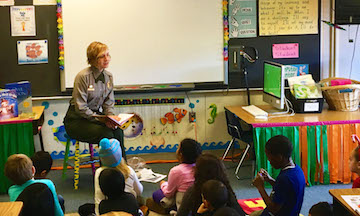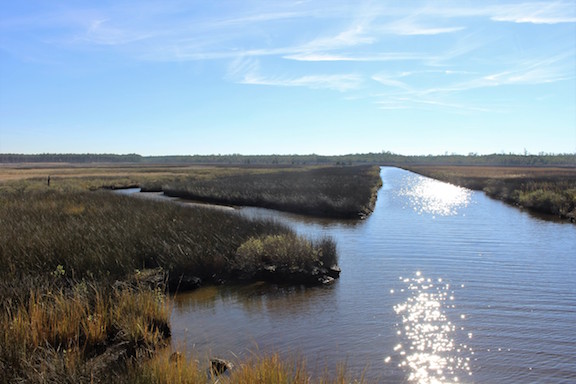WHM Profile: Beth Parnicza


by ECW Correspondent Emily Losito
Elizabeth Parnicza stood next to the edge of Stewarts Canal in Maryland, which the abolitionist Harriet Tubman and her father worked on during their time of slavery. The canal was built between 1810 and 1830 while Tubman was still a child.
“I knew I was steps away from the legend at work, and it’s just breathtaking. Every day, you remind yourself that you’re working on, and are a part of, history,” she said.
Parnicza, who has worked for the National Park Service since 2011, is among the staffers preparing to launch the new Harriet Tubman Underground Railroad Visitor Center in Church Creek, Maryland. The park officially opens its doors on Saturday, March 11.The West Virginia native first got her taste for history when she volunteered as a local historian.
“I didn’t decide I wanted to be a historian until the end of my high school career. My family is heavily involved in technology and engineering…but I figured out I loved reading and history and people,” she said. “I read mostly about people, and the more I could dig into their history, the more I got caught up in it. It was compelling and fascinating that I could share their experiences.”

Parnicza’s work for the National Park Service has focused mostly on interpretation—that is, helping visitors understand the history at each of the places she’s worked. She has also done social media outreach for her parks, especially at Fredericksburg during the Civil War’s 150-year anniversary back between 2011 and 2015.
“I work at Fredericksburg and Spotsylvania and have worked at Monocacy before,” Parnicza said. “One of the main differences between Fredericksburg and Harriet Tubman is that Fredericksburg is well-established and large. There are four major battlefields to manage and all kinds of resources…. With Harriet, it’s smaller, and now there’s three of us. There’s a lot more to pick up.”
One way to do that, she said, is to look at the successful things other national parks have done.
“We learn and see what other people are doing so we can borrow ideas, modify them, and see if we’re doing a lot of the same things,” she explained. It’s a technique she drew on often during the Civil War Sesquicentennial. “When we were planning the 150-year anniversary, we looked at what parks did, what were the most powerful things, whether they had shuttles to and from the parks,” she said.
The new visitor center is managed through a partnership between the National Park Service and the Maryland Park Service.
Public response to the Harriet Tubman Underground Railroad National Historical Park has been “phenomenal” so far, Parnicza said. “Almost all of the responses we’ve had have been overall positive. The life she led was exemplary. The more anyone learns about her, the more they think ‘How don’t we have a park about her already?’” she said. “She’s going to be on the 20 dollar bill.”
Parnicza added that people near and far are excited to learn about the life of Tubman before and after the Underground Railroad.
As a young woman working at a park dedicated to the life and work of another woman, Parnicza has had the opportunity to see and be a role model. “In 2008, I was the only female intern, but now it’s shifting to half-and-half,” she said, indicating a larger trend of more women working at Civil War-related parks. “It’s important to see more women in the field. It’s a different perspective and it offers different backgrounds into the field.”
Parnicza said she encourages young women to get into the field.
“One day I was leading a school group, and I turned around to see a ring of girls around me. That’s when it clicked. It makes a difference for girls to see that men and women can talk about the Civil War. It helps reinforce the idea that women can go into science and engineering and really, any field,” she said. “Women can do these things too. You don’t have to be a specific gender or color—there’s a place for you here.”
Parnicza also gets to talk with “an awesome mix of historic and modern” people at the museum.
“There’s so much to learn and constantly research. I get to work with modern people, and I get to ask people questions, whether they’re in military groups that will use Civil War strategies, or just sharing stories with people who find them compelling,” she said.
Talking about people she’s researched, like Harriet Tubman, is something that Parnicza loves to do. “It’s been a really great opportunity to expand horizons. Harriet has to be one of the most fascinating people I’ve encountered,” Parnicza said.
While most people familiar with Tubman know of her involvement with the Underground Railroad, she did have her own Civil War adventures, too, Parnicza said. For instance, Tubman was involved in the Combahee River Raid in South Carolina. Parnicza said Tubman used information to safely lead Col. James Montgomery and his men up the Combahee River past all of the mines in the water. She then helped free the slaves that were on the plantations there.
“Multitudes of the enslaved flocked to the riverbank to escape aboard the gunboats, and in the chaos, Harriet Tubman sang to calm the people who were fearful that the boats would leave without them,” Parnicza said. “In all, Tubman and the Union forces carried more than 750 people to freedom.”
She added that there is a lot about “Harriet” that draws her in.
“The ground she walked and the things she did…her escaping, returning, and hiding out on the Eastern Shore. She’s an excellent model of character, and she shows us how much choice we have and that we can really live our ideals if we have the strength and courage,” Parnicza said. “She grew up seemingly without choices, but with her family and friends, she knew what was right and acted on that resolution. Issues become far less complicated when you know you are acting on what’s right, no matter what odds are stacked against you.”

What an incredible park and story to be a part of, Beth! Best of luck to you and Harriet Tubman Underground Railroad National Historical Park. I know I will be there next time I am in the area!